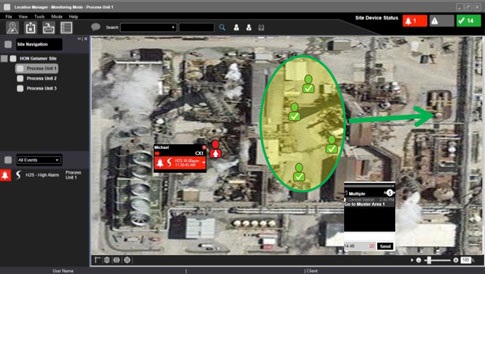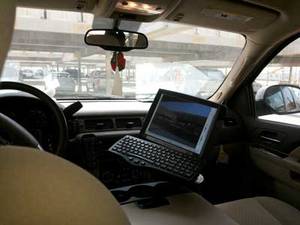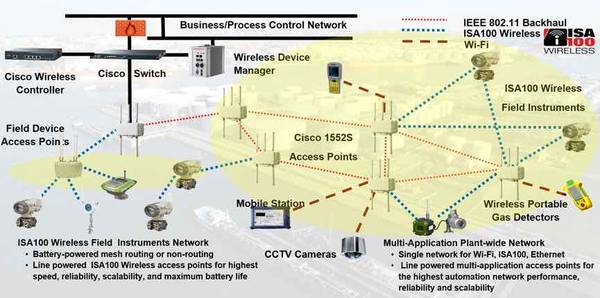Technology Update: Industrial wireless takes on high-bandwidth mobile video monitoring at a refinery and mission-critical safety leak detection at an LNG facility.

 Reliable industrial wireless technology is being applied in high-bandwidth mobile video monitoring in a refinery and for alarming at a liquid natural gas (LNG) facility. Industrial wireless networks have improved bandwidth, latency, and reliability to have dramatically expanded the scope of potential applications.
Reliable industrial wireless technology is being applied in high-bandwidth mobile video monitoring in a refinery and for alarming at a liquid natural gas (LNG) facility. Industrial wireless networks have improved bandwidth, latency, and reliability to have dramatically expanded the scope of potential applications.
The current hype around the Industrial Internet of Things (IIoT) is well founded with potential to bring radical change processes across industry. IIoT does face development barriers including continuing and justifiable caution around the use of public networks for critical applications in process control and safety.
As industrial facilities and their service providers continue to wrestle with IIoT challenges, established, field-proven, wireless technology innovations are driven by customer requirements and willingness to apply the best available technology in new ways. Doing so brings new levels of safety, reliability, and efficiency. Industrial wireless case studies below illustrate the potential.
Moving pictures
The first case is a mobile video monitoring solution applied at the Samref refinery complex in Yanbu, Saudi Arabia. Since 2013, Samref has used a wireless network to enable Wi-Fi clients and ISA100 Wireless field instruments to wirelessly connect and to obtain measurements in hard-to-access locations; this works consistently and reliably in areas previously considered impractical or off-limits.
Even with the flexibility to quickly and cost-effectively employ wireless closed-circuit television (CCTV) cameras, however, it is impossible to cover the entire site. As a result, those in the central control room can end up with no view of intrusions, fires, explosions, or other incidents facing emergency response teams. Plant managers or operations directors are left in the dark, usually completely reliant on verbal information from the teams on the ground.
 To overcome this problem, an industrial wireless provider worked with Samref to deploy a live video solution for its emergency command vehicle, a first responder to any incident.
To overcome this problem, an industrial wireless provider worked with Samref to deploy a live video solution for its emergency command vehicle, a first responder to any incident.
A wireless pan tilt zoom video camera was mounted on the roof of the command vehicle (see Figure 1). This streams live video to the control room using the wireless network, where it is displayed and recorded by a digital video manager CCTV surveillance monitor. To ensure the camera is capturing a useful image, the video displayed in the control room is fed back to a wireless vehicle-mounted tablet computer (see Figure 2). This is used by those in the vehicle to direct and zoom the camera.
With modern Wi-Fi technology it is important to note:
- Bandwidth supports video streaming of live high-definition video at up to 30 frames a second. It ensures an uninterrupted feed in both the control room and on the vehicle monitor.
- Reliability of a wireless mesh network provides full, dependable coverage across the refinery site.
Each ISA100 Wireless field device and each wireless access point (AP) automatically discovers neighboring ISA100 Wireless devices and establishes a communication path with them. In the event of a failure of one device or access point, the network instantly activates the connection to another neighboring device.
The wireless network (see Figure 3) is self-organizing and self-healing, providing a robust network with multiple redundant communication paths.

Safety first
This better-than-wired reliability is also combined with wired-like performance in terms of latency-vital for safety and compliance applications.
One of the world’s leading integrated LNG businesses worked with an industrial wireless provider for communications for a gas leak alarm system in its administration area. Regulatory requirements stipulated the alarm must sound within 3 seconds of detection of a leak and that audible (horns) and visual (beacons) elements must activate simultaneously. Field components, including detectors, transmitters, sounders, and beacons, had to be independent of line power.
Crucial factors included:
1. Fast response time: The 250 millisec latency enabled by the ISA100 wireless system. To ensure the 3-sec response times, the system was also configured so that sensors communicated only with the access points (rather than using other sensors as repeaters), since the access points offered near real-time performance of 100 millisec.
2. System components: The system relies on field device APs, a wireless device manager (WDM) system and gateway, input/output (I/O) transmitters, which activate the audio and visual alarms.
3. Redundancy: The system also includes two WDMs to provide a redundant interface to the safety programmable logic controller (PLC). The pole-mounted horns and beacons have a solar power panel and buffer battery to provide (line power independent) power.
In testing, the system consistently realized the stringent cycle-time requirement: From the toxic gas detectors, to the gas analyzer and system panel, through several converters, to the remote terminal unit (RTU) acting as Modbus master, and the WDM, before finally passing to wireless I/O transmitters, the activation time was just 2.9 sec, with all horns and beacons activating simultaneously.
Not every wireless network can meet the maximum latencies for such applications. Moreover, careful network design was crucial to ensuring the required response times were met. Established technology was used in the Samref wireless application.
Portable gas detection
 Existing industrial wireless technologies are moving closer to functionality associated with IIoT.
Existing industrial wireless technologies are moving closer to functionality associated with IIoT.
For example, portable gas detection and mustering can use wireless to communicate to personal safety devices worn by those around the site and configured to detect multiple gases or low-oxygen levels, as well as alarms-on both the device and in the control room-in the event of gas detection, calibration failures, or low batteries. These alarms also automatically trigger alerts and text messages to users to return to base. Similarly, alarms and text messages in the event of a gas detection alert all others to gather at mustering stations. The system also allows movements of people to be tracked visually on screen in the control room (see Figures 4 and 5) and provides notification to operators of any failure to move to the mustering area or immobility. E-mails, text messages, and other notifications are configured to alert plant managers and other stakeholders of any events in real time.
The system provides complete, real-time visibility of the location and movements of all personnel and enables intelligent proactive responses in the event of leaks or accidents. It also automates recording of all incidents, as well as day-to-day movements for compliance purposes, significantly reducing the regulatory burden.
 While IT remains on a private network, the industrial wireless applications approach a level of automation and real-time information appropriate for the IIoT while using secure, robust, field-proven technology. Users’ imaginations are driving additional innovative applications.
While IT remains on a private network, the industrial wireless applications approach a level of automation and real-time information appropriate for the IIoT while using secure, robust, field-proven technology. Users’ imaginations are driving additional innovative applications.
– Diederik Mols is business leader, industrial wireless, Honeywell Process Solutions. Edited by Mark T. Hoske, content manager, CFE Media, Control Engineering, [email protected].
Key concepts
- Industrial wireless applications bring new levels of safety, reliability, and efficiency.
- Industrial wireless case studies at a refinery and LNG facility provide examples of Industrial Internet of Things (IIoT) abilities, even if on a private network.
Consider this
Industrial wireless, properly applied, can be secure and reliable for many mission-critical applications.
ONLINE extra
This online posting has more information and three additional figures than what appeared in Control Engineering December 2015 issue.
See the Control Engineering wireless page.
More than 40 industrial wireless tutorials are available.
See related stories linked below.


